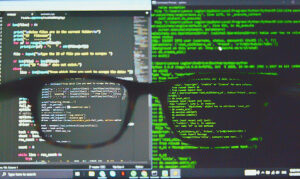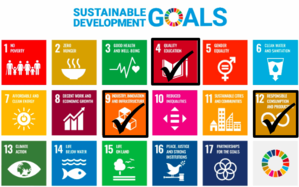Special Track: Green Coding
 The resource- and energy consumption of information and communication technology (ICT) is continuously increasing. While the production, usage, and disposal of the hardware components for data centers, networks, and end devices consumes the resources, it is the software that induces the need for these components to be produced. The energy and resource consumption of the hardware has been researched for many years under the term Green IT. However, it is the software that triggers the consumption of the hardware: it activates or disables energy-saving modes, transfers, and stores large amounts of data, and thus triggers computing operations. Hence, it has a significant influence the energy consumption, energy efficiency, and useful life and therefore on the energy and resource consumption of ICT in general. Despite its great importance, general regulation or even recommendations for sustainable software are still in its infancy.
The resource- and energy consumption of information and communication technology (ICT) is continuously increasing. While the production, usage, and disposal of the hardware components for data centers, networks, and end devices consumes the resources, it is the software that induces the need for these components to be produced. The energy and resource consumption of the hardware has been researched for many years under the term Green IT. However, it is the software that triggers the consumption of the hardware: it activates or disables energy-saving modes, transfers, and stores large amounts of data, and thus triggers computing operations. Hence, it has a significant influence the energy consumption, energy efficiency, and useful life and therefore on the energy and resource consumption of ICT in general. Despite its great importance, general regulation or even recommendations for sustainable software are still in its infancy.
Digital business models, the production, operation and disposal of end devices, the components of digital infrastructures for data centers and communications networks, and the rapid growth in data traffic and compute-time – all this leads to ever higher consumption of energy and resources. For digital transformation to unleash its potential for protecting the environment, climate and resources, its own ecological footprint must be as small as possible. To structure and assess this complex interplay and to be able to evaluate potential negative and positive effects, a multi-level model has become established for analyzing the environmental effects, but also other impacts, of digital technologies.
Direct or first-order effects occur along the life cycle – i.e., the production, distribution, use, and disposal or recycling – of ICT products, such as mobile devices, network infrastructures and data centers. Although there has been extensive research on these direct effects for around two decades, using recognized methods such as life cycle assessments or life cycle cost analyses, there are still considerable gaps in their assessment, for example with regards to the social costs of manufacturing ICT products. In addition, technological change requires constant readjustment of the analytical methods and new data bases. As a result, at the moment they appear, such analyses often depict the effects of an already outdated state of the art. Therefore, only limited forecasts for the future can be derived from the evaluation of direct effects of digital technologies. Green Coding addresses these effects.
Indirect or second-order effects refer to all those changes in resource use and environmental consumption, but also in the economy and society in general that result from the use of ICT in various application areas.
Systemic or third-order effects arise from the complex interactions between digital technologies and fundamental societal structures and relationships, such as lifestyles, organization and forms of work, the energy system, consumption and production patterns, opportunities for participation in society, and many more. Here, rebound effects and unintended consequences arise, as well. Due to their multi-layered interactions, these effects defy clear quantification and can, at best, be modeled approximately with a view to the future using scenario methods that include a large number of potential influencing factors.
Consequently, far-reaching processes of social change during the digital transformation cannot be viewed in isolation from their effects on the natural environment and developments such as anthropogenic climate change. Because direct environmental effects include the resource consumption and emissions caused by the Software directly and systemic effects address cultural, social, and systemic changes, e.g., programming concepts, company/organizational views, teaching and knowledge transfer regarding Green Coding and awareness for the resource consumption of ICT, in this track, we lay a special focus on first- and third-order effects.
Papers can focus on, but are not limited to
- Green Coding techniques, methodology, platforms, and tools,
- green platforms, frameworks, algorithms, programming languages,
- methods for measuring and analyzing software-induced energy and resource consumption,
- metrics, indicators, and criteria for resource and energy efficient software,
- tools for assessing the sustainability of software,
- energy-aware software engineering,
- concepts and reference models for green software,
- best practice examples,
- exemplary assessment of software products, including open-source products,
- transparency, user autonomy, contuniutiy, independance, maintainability, quality, and licensing as factors in Green Coding,
- green coding in universities and in industry and
- green coding in different IT disciplines (AI, IoT, distributed systems, mobile, etc.).
Organizers
- Christian Bunse, Stralsund University of Applied Sciences
- Joseph P. De Veaugh-Geiss, KDE e. V.
- Achim Guldner, Trier University of Applied Sciences, Environmental Campus Birkenfeld
- Eva Kern, Leuphana University Lüneburg
- Sandro Kreten, capacura GmbH
- Stefan Naumann, Trier University of Applied Sciences, Environmental Campus Birkenfeld
- Benno Schmidt, Bochum University of Applied Sciences
- Andreas Winter, University of Oldenburg
- Volker Wohlgemuth, Environmental Informatics Unit, HTW Berlin, University of Applied Sciences

